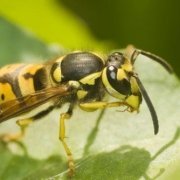Control of Flies
Usually the odd fly doesn’t bother us, it’s only when we notice a few flies buzzing about the place that we get annoyed.
A Bluebottle heading toward to light and banging its head against the window sometimes catches our attention or a green bottle getting a bit to near to our dinner is obviously never a good sign but you can deal with that yourself, by either opening a window or chasing it around with a rolled-up newspaper.
It’s when we notice that the windowsill is covered with black flies, on their backs, with their legs in the air that most people start to become inquisitive as to, why they are there and where they come from.
All flies have the potential to spread germs and diseases.
Cluster Flies:
Cluster Flies have become much more of a common problem over the last few years. So much so in fact that we started to look into the movements, breeding cycle and habits of these little pests, so we could deal with them for you.
The flies cluster on the warm sides of buildings in late summer during the day. When the sun goes down and the temperatures cool, these flies crawl into the building through cracks under the eaves and around windows or through gaps on the roof. Once inside and secured in a protected location, they remain in hibernation until warmed by the natural heat of the sun.
Adult flies can lay their eggs outside or inside the property. They leave a secretion on the timber in attic areas or false ceiling voids and return year on year in ever increasing numbers, if left untreated.
These black invaders can be become problematic inside properties in autumn and sometimes in spring and they will typically gather in swarms. They will gather around windows as they are attracted to light during the day and then move and hibernate in roof spaces at night. Naturally, you don’t want to share your property with swarms of flies and for a business, it’s not a great way to attract customers either.
If you notice an infestation, you are likely to need the help of a professional pest controller who can use treatments such as residual sprays to target all active flies and others as they emerge from hibernation. But beware, there may be other creatures such as Bats that could be affected.
All Bats in the UK are protected by the Wildlife and Countryside Act 1981 and it is illegal to use any insecticides if it might come into contact with bats.
Obviously, we at Pestwise, are trained to use the correct product through the most effective machine to get the very best results to rid you and your property of these annoying pests
Blue/Green Bottles
Blow flies, often referred to as Bluebottle or Greenbottles, have a massive potential to spread germs and diseases.
The main method of control is to find and remove the cause of the problem. That is usually rotting food stuffs or a decomposing dead bird or animal. Infested food should be quite easy to find and remove. A dead animal however cannot always be found. Good places to check are lofts (for birds, squirrels, etc), behind old fireplaces, under floor boards and behind bath panels, kitchen appliances and cupboards.
Whether the cause is found or not, the use of an effective insecticide is recommended. For areas where the cause is found, an Ultra-Low Volume (ULV) insect spray can be used. Other means of treatment include professional fly traps, which can be hung up and ultra violet electric killers.
The beauty of the ULV spray is that the product reaches in to all the “nooks and crannies” in areas found in all buildings. The use our ULV machines are quick and efficient and our trained staff report a very high success rate on all types of Flies in large or small roof voids.
Beware – Do not try to treat any insect or fly in an enclosed space using an insecticidal spray without use of the correct breathing apparatus and filter.





